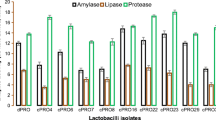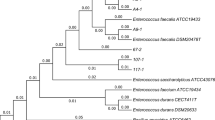Abstract
Some strains of the genus Enterococcus are effective probiotic bacteria if they meet safety and probiotic criteria. In our study, 17 canine enterococci previously selected from a group of 160 isolates based on safety criteria were screened for some functional properties relevant to their use as probiotics. The results of antimicrobial resistance testing showed sensitivity of eleven strains to EFSA recommended antimicrobials. In contrast, the most frequent resistance was observed for cefotaxim (15/17) and oxacillin (13/17). PCR detection of resistance genes (vanA, vanB, vanC, tetM, tetL, ermB, and mefA) revealed the presence of mefA gene in five Enterococcus faecium strains and vanA gene in one strain. The production of enzymes commonly associated with intestinal diseases was in general rare (β-glucosidase 2/17, α-chymotrypsin 1/17, N-acetyl-β-glucosaminidase 0/17, and β-glucuronidase 0/17). The measurement of strain survival rate (%) under the conditions simulating gastric (pH 2.5) and bile juices (0.3% bile) showed considerable differences between strains (< 0.01 to 4.7% after 90 min for gastric juices, 48.0 to 254.0% after 180 min for bile). The concentration of produced l-lactic acid ranged between 83.1 to 119.3 mmol/L after 48 h cultivation depending on the strain. All strains fermented 16 out of 49 different carbohydrates (range from 17 to 23/49). Antimicrobial activity was recorded for two strains against some species of Listeria sp. and Enterococcus sp. Finally, two E. faecium candidates (IK25 and D7) were selected for testing in dogs, and hereafter they could possibly extend the currently limited range of beneficial bacteria of canine origin used as a dietary supplement for dogs.
Similar content being viewed by others
References
Arboleya S, Ruas-Madiedo P, Margolles A, Solís G, Salminen S, de Los Reyes-Gavilán CG, Gueimonde M (2011) Characterization and in vitro properties of potentially probiotic Bifidobacterium strains isolated from breast-milk. Int J Food Microbiol 149:28–36
Aymerich T, Holo H, Havarstein LS, Hugas M, Garriga M, Nes IF (1996) Biochemical and genetic characterization of enterocin A from Enterococcus faecium, a new antilisterial bacteriocin in the pediocin family of bacteriocins. Appl Environ Microbiol 62:1676–1682
Baele M, Chiers K, Davriese LA, Smith HE, Wisselink HJ, Vaneechoutte M, Haesebrouck F (2001) The gram-positive tonsillar and nasal flora of piglets before and after weaning. J Appl Microbiol 91:997–1003
Bessède E, Angla-gre M, Delagarde Y, Sep Hieng S, Ménard A, Mégraud F (2011) Matrix-assisted laser-desorption/ionization biotyper: experience in the routine of a university hospital. Clin Microbiol Infect 17:533–538
Biavasco F, Foglia G, Paoletti C, Zandri G, Magi G, Guaglianone E, Sundsfjord A, Pruzzo C, Donelli G, Facinelli B (2007) VanA-type enterococci from humans, animals, and food: species distribution, population structure, Tn1546 typing and location, and virulence determinants. Appl Environ Microbiol 73:3307–3319
Billington EO, Phang SH, Gregson DB, Pitout JDD, Ross T, Church DL, Laupland KB, Parkins MD (2014) Incidence, risk factors, and outcomes for Enterococcus spp. blood stream infections: a population-based study. Int J Infect Dis 26:76–82
CAROdog. Statistics. http://www.carodog.eu/statistics-on-cats-and-dogs/#world
Casaus P, Nilsen T, Cintas LM, Nes IF, Hernández PE, Holo H (1997) Enterocin B, a new bacteriocin from Enterococcus faecium T136 which can act synergistically with enterocin A. Microbiol 143:2287–2294
Christensen HR, Frøkiaer H, Pestka JJ (2002) Lactobacilli differentially modulate expression of cytokines and maturation surface markers in murine dendritic cells. J Immunol 168:171–178
Cintas LM, Casaus P, Håvarstein LS, Hernández PE, Nes IF (1997) Biochemical and genetic characterization of enterocin P, a novel sec-dependent bacteriocin from Enterococcus faecium P13 with a broad antimicrobial spectrum. Appl Environ Microbiol 63:4321–4330
Cintas LM, Casaus P, Holo H, Hernández PE, Nes IF, Håverstein LS (1998) Enterocins L50A and L50B, two novel bacteriocins from Enterococcus faecium L50 are related to staphylococcal hemolysins. J Bacteriol 180:1988–1994
De Preter V, Raemen H, Cloetens E, Houben E, Rutgeerts P, Verbeke K (2008) Effect of dietary intervention with different pre- and probiotics on intestinal bacterial enzyme activities. Eur J Clin Nutr 62:225–231
De Vuyst L, Foulquie Moreno MR, Revets H (2003) Screening for enterocins and detection of hemolysin and vancomycin resistance in enterococci of different origin. Int J Food Microbiol 84:299–318
D'Ercole S, Petrelli D, Prenna M, Zampaloni C, Catania MR, Ripa S, Vitali LA (2005) Distribution of mef(A)-containing genetic elements in erythromycin-resistant isolates of Streptococcus pyogenes from Italy. Clin Microbiol Infect 11:927–930
Dobson A, Cotter PD, Ross RP, Hill C (2012) Bacteriocin production: a probiotic trait? Appl Environ Microbiol 78:1–6
Dressman JB (1986) Comparison of canine and human gastrointestinal physiology. Pharm Res 3:123–131
Dutka-Malen S, Evers S, Courvalin P (1995) Detection of glycopeptide resistance genotypes and identification to the species level of clinically relevant enterococci by PCR. J Clin Microbiol 33:24–27
EFSA Panel on Additives and Products or Substances usen in Animal Feed (FEEDAP) (2012a) Guidance on the safety assessment of Enterococcus faecium in animal nutrition. EFSA J 10:2682
EFSA Panel on Additives and Products or Substances usen in Animal Feed (FEEDAP) (2012b) Guidance on the assessment of bacterial susceptibility to antimicrobials of human and veterinary importance. EFSA J 10:2740
Global Industry Analysts Inc. (2011). Global market opening for lactic acid [WWW document]. http://www.prweb.com/releases/2011/1/prweb8043649.htm/
Grześkowiak Ł, Endo A, Beasley S, Salminen S (2015) Microbiota and probiotics in canine and feline welfare. Anaerobe 34:14–23
Hummel AS, Hertel C, Holzapfel WH, Franz CM (2007) Antibiotic resistances of starter and probiotic strains of LAB. Appl Environ Microbiol 73:730–739
Jain S (2017) A study on susceptibility pattern of nitrofurantoin in clinical isolates of Enterococcus. Natl J Integr Res Med 8:53–56
Jensen LB, Frimodt-Moller N, Aarestrup FM (1999) Presence of erm gene classes in gram-positive bacteria of animal and human origin in Denmark. FEMS Microbiol Lett 170:151–158
Juers DH, Matthews BW, Huber RE (2012) LacZ β-galactosidase: structure and function of an enzyme of historical and molecular biological importance. Protein Sci 21:1792–1807
Kastner S, Perreten V, Bleuler H, Hugenschmidt G, Lacroix CH, Meile L (2006) Antibiotic susceptibility patterns and resistance genes of starter cultures and probiotic bacteria used in food. Syst Appl Microbiol 29:145–155
Kataoka Y, Umino Y, Ochi H, Harada K, Sawada S (2014) Antimicrobial susceptibility of enterococcal species isolated from antibiotic-treated dogs and cats. J Vet Med Sci 76:1399–1402
Kubašová I, Strompfová V, Lauková A (2017) Safety assessment of commensal enterococci from dogs. Folia Microbiol 62:491–498
Kumar S, Pattanaik AK, Sharma S, Gupta R, Jadhav SE, Dutta N (2017) Comparative assessment of canine-origin Lactobacillus johnsonii CPN23 and dairy-origin Lactobacillus acidophillus NCDC 15 for nutrient digestibility, faecal fermentative metabolites and selected gut health indices in dogs. J Nutr Sci 6:e38
Lebreton F, Willems RJL, Gilmore MS (2014) Enterococcal species: natural and man-made habitats. In: Gilmore MS, Clewell DB, Ike Y et al (eds) Enterococci: from commensals to leading causes of drug resistant infection. Massachusetts Eye and Ear Infirmary, Boston
Minelli EB, Beninin A (2008) Relationship between number of bacteria and their probiotic effects. Microb Ecol Health Dis 20:180–183
Nes IF, Holo H (2000) Class II antimicrobial peptides from lactic acid bacteria. Biopolym 55:50–61
Ness IF, Diep DB, Ike Y (2014) Enterococcal bacteriocins and antimicrobial proteins that contribute to niche control. In: Gilmore, MS, Clewell, DB, Ike Y et al. (Eds.) Enterococci: from commensals to leading causes of drug resistant infection [internet]. Boston: Massachusetts Eye and Ear Infirmary
Nonaka L, Ikeno K, Suzuki S (2007) Distribution of tetracycline resistance gene, tet (M) in gram-positive and gram-negative bacteria isolated from sediment and seawater at a coastal aquaculture site in Japan. Microbes Environ 22:355–364
Ossiprandi MC, Zerbini L (2015) Antimicrobial susceptibility of enterococcal species isolated from Italian dogs. In: Ossiprandi MC (ed.) Antimicrobial resistance - an open challenge, Ossiprandi, M.C. (Ed.), InTech, https://doi.org/10.5772/61778
Park YH, Cho KM, Kim HW, Kim C (2010) Method for producing lactic acid with high concentration and high yield using lactic acid bacteria. CJ Cheiljedang Corp. U.S., patent 7682814 B2
Ramsey M, Hartke A, Huycke M (2014) The Physiology and Metabolism of Enterococci. In: Gilmore MS, Clewell DB, Ike Y et al (eds) Enterococci: from commensals to leading causes of drug resistant infection. Massachusetts Eye and Ear Infirmary, Boston
Roberts MC (1994) Epidemiology of tetracycline resistance determinants. Trends Microbiol 2:353–357
Schmitz S, Suchodolski J (2016) Understanding the canine intestinal microbiota and its modification by pro-, pre- and synbiotics – what is the evidence? Vet Med Sci 2:71–94
Skalka B, Pillich J, Pospíšil L (1983) Further observation on Corynebacterium renale as an indicator organism in the detection of exfoliation-positive strains Staphylococcus aureus. Zentralbl Bakteriol Hyg A256:168–174
Song SJ, Lauber C, Costello EK, Lozupone CA, Humphrey G, Berg-Lyons D, Caporaso G, Knights D, Clemente JC, Nakielny S, Gordon JI, Fierer N, Knighet R (2013) Cohabiting family members share microbiota with one another and with their dogs. eLife 2:e00458
Stovcik V, Javorsky P, Pristas P (2008) Antibiotic resistance patterns and resistance genes in enterococci isolated from sheep gastrointestinal tract in Slovakia. Bull Vet Inst Pulawy 52:53–57
Strompfová V, Lauková A, Ouwehand AC (2004) Lactobacilli and enterococci--potential probiotics for dogs. Folia Microbiol 49:203–207
Strompfová V, Lauková A, Simonová M, Marciňáková M (2008) Occurrence of the structural enterocin A, P, B, L50B genes in enterococci of different origin. Vet Microbiol 132:293–301
Subramanian MR, Talluri S, Christopher LP (2015) Production of lactic acid using a new homofermentative Enterococcus faecalis isolate. Microb Biotechnol 8:221–229
The European Committee on Antimicrobial Susceptibility Testing (2017) Breakpoint tables for interpretation of MICs and zone diameters. Version 7.0. http://www.eucast.org
Weese JS, Anderson EC (2002) Preliminary evaluation of Lactobacillus rhamnosus strain GG, a potential probiotic in dogs. Can Vet J 43:771–774
Yun JS, Wee JY, Ryu HW (2003) Production of optically pure l(+)-lactic acid from various carbohydrates by batch fermentation of Enterococcus faecalis RKY1. Enzym Microb Technol 33:416–423
Zdolec N (2017) Fermented meat products: health aspects. CRC Press, Boca Raton 572 pages, ISBN 9781315352831
Funding
The study was funded by the Slovak Scientific Agency VEGA (no. 2/0012/16).
Author information
Authors and Affiliations
Corresponding author
Rights and permissions
About this article
Cite this article
Kubašová, I., Lauková, A., Hamarová, Ľ. et al. Evaluation of enterococci for potential probiotic utilization in dogs. Folia Microbiol 64, 177–187 (2019). https://doi.org/10.1007/s12223-018-0640-1
Received:
Accepted:
Published:
Issue Date:
DOI: https://doi.org/10.1007/s12223-018-0640-1




